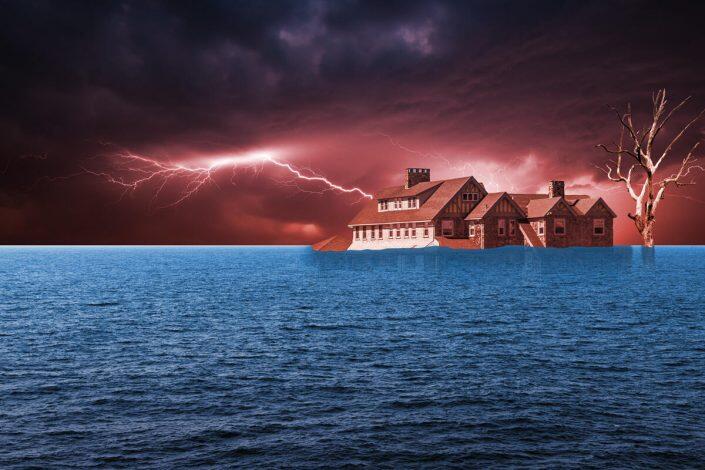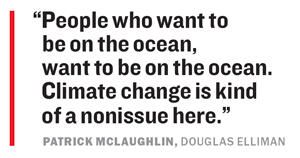 Sea levels are rising. Catastrophic storms are increasing. Temperatures are soaring to unprecedented highs.
Sea levels are rising. Catastrophic storms are increasing. Temperatures are soaring to unprecedented highs.
Yet here in the Hamptons, oceanfront property is at an all-time premium. One Southampton estate is asking $175 million. Another is in contract with a last asking price of $145 million; its listing agency, Bespoke, says it’s a record sum for a single parcel. A new listing asks $85 million for “the largest single lot on the ocean in Southampton village” at 9.75 acres. All of them, obviously, are at or near sea level.
Climate change is the third rail of Hamptons real estate. Few are willing to talk about it, and even fewer on the record. Many owners refuse to think about it.
Part of the issue might be what writer Margaret Heffernan calls “willful blindness” in her book of the same name. She argues that the biggest dangers are the ones we don’t see — not because they’re secret, but because we refuse to pay attention to them.
What is no secret is that the extremely rich tend to gravitate to the political right, especially in the Wall Street-wealthy Hamptons. And conservatives are less likely to be outwardly concerned about global warming. A 2019 Gallup poll identified 81 percent of liberals as “concerned believers” in climate change, as opposed to 25 percent of conservatives. In total, 45 percent of Americans believed climate change would pose a serious threat in their lifetime.
In March 2020, a paper printed in the Review of Financial Studies claimed that “all else being equal, homes located in climate change ‘denier’ neighborhoods sell for about 7 percent more than homes in ‘believer’ neighborhoods” and that “heterogeneity in beliefs about long-run climate change risks significantly affects the U.S. real estate market.”
If you don’t think climate change is a threat, you don’t worry about your oceanfront property — the cachet of which is as great as ever.
 “People who want to be on the ocean, want to be on the ocean,” said Douglas Elliman’s Patrick McLaughlin. “Climate change is kind of a nonissue here for many in the Hamptons.”
“People who want to be on the ocean, want to be on the ocean,” said Douglas Elliman’s Patrick McLaughlin. “Climate change is kind of a nonissue here for many in the Hamptons.”
Yet, as a Bloomberg story bluntly assessed in 2018, “Almost no city stands to lose as much money from climate change as Southampton, New York.” Data gathered by the Union of Concerned Scientists indicates that Southampton was No. 2 in the amount of property tax revenue at risk from chronic flooding, behind only the central coast of California.
Another group, Climate Central, an organization of scientists and journalists, predicts that rising sea levels from melting polar ice will overwhelm much of the Hamptons shoreline.
Clearly, coastal residential real estate is at risk. What about business? The only hamlet with a lot of oceanfront business is Montauk, which also happens to have the lowest-lying downtown in the Hamptons. In 2012, floodwaters from Superstorm Sandy breached the dunes and would have flooded the neighborhood if East Hampton Town bulldozers had not quickly plugged up the area.
Ever since then, arguments have raged about the Army Corps of Engineers’ sandbagging of the downtown dunes, sand replenishment and the costs thereof and a proposal to move all oceanfront businesses, if not the entire downtown, to higher ground.
Paul Monte, president of the Montauk Chamber of Commerce, is not convinced.
“The idea of trying to relocate all of the businesses and hotels that are along the beach right now, as well as possibly the entirety of the downtown area, has been a recommendation of the Montauk Hamlet study for the past several years,” he said. “We at the Chamber recommend putting that on hold while we delve deeper into the economic impact and the actual feasibility of the plan. Not only to the businesses and the people that work there, but to the community and the economy of the entire East Hampton Town.”
The town has long been at the vanguard of plans to combat climate change among the local communities. It set a goal of deriving 100 percent of its energy consumption from renewable sources by 2030. This year, the town board approved plans to build a 15-turbine offshore wind farm 30 miles southeast of Montauk Point. Work is expected to be completed in 2023.
The project will be the first offshore wind farm in New York, but it is not without controversy. The Montauk fishing fleet, the largest in the state, is concerned about fish stocks in the region, and homeowners in Wainscott, where the underwater cable will make landfall on its way to a substation in East Hampton, are suing the town.
Still, changes will need to be made, not just locally but globally, to combat climate change and the accompanying rises in sea level and storm activity. Yet those who live on the coastline, especially homeowners, are the ones most likely to suffer its effects.
A coastal property collapse could easily surpass the dot-com and real estate crises of 2000 and 2008.
“A decade or two from now — perhaps much sooner — we may be parsing the early signs of the Coastal Housing Crisis, brought on by climate change and its rising seas,” reads a March essay in the Anderson Review, a publication of UCLA’s management school. “If present trends continue, that crisis would also involve soaring home prices and mortgage debt in the most flood-vulnerable zones, and regular, if not catastrophic, flooding that makes once-prized areas undesirable, if not unlivable.”
The paper’s conclusion? Hundreds of billions of dollars in losses, given the $1 trillion-plus size of the market. Under water, indeed.
